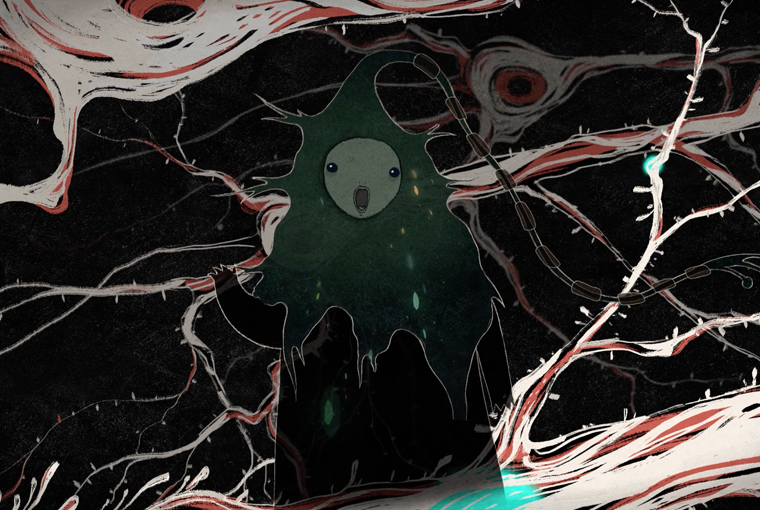So Afraid to Be a Woman
Signe Baumane’s My Love Affair With Marriage (2022)
Vol. 129 (November 2022) by Julia Skala
Signe Baumane’s semi-autobiographical My Love Affair With Marriage is a dazzling demonstration of how contemporary adult animation addresses societal double standards. It was one of three feature films shown at Primanima Animation Festival in Budaörs, Hungary, screening alongside Tomasz Wolski’s stop motion documentary 1970 (2021) and Florence Miailhe’s animated drama The Crossing (2021).
My Love Affair with Marriage tells the story of Zelma, a girl born in Latvia, who we witness growing up – beginning from her very conception as a fetus, through her childhood and adolescence and finally, to her second divorce as a young woman. Zelma already feels a strong urge for love as a young girl in school. She is possessed by the thought that a significant other will complete her. After a disappointing first sexual experience with a meaningless fling, Zelma meets Sergei in university. She finds him charming and intelligent, and they fall in love. Zelma now experiences the ecstatic, spiritual oneness that she was longing for. Once Sergei casually proposes to her, Zelma feels she is on the right track – marriage is just what her mother had her striving for all along. Unfortunately, Sergei, who is an indolent and unsuccessful artist, fails to make a living off of his work, while Zelma, who is also a striving artist, is rising to success. After facing infidelity and emotional manipulation at the hands of Sergei, the unequal couple finally divorce. When traveling to an exhibition abroad, Zelma meets Swedish artist Bo, who she instantly clicks with. Their passionate romance transcends the distance from Sweden to Latvia, where Bo frequently visits Zelma. They too, finally marry and move to the US together. Zelma, jobless and bored, feels unhappy with her life there and suspects the reason for this in Bo. They too, drift apart and finally, divorce. Now, after her second divorce and yet still in her twenties, a new life can begin for Zelma.
Director Signe Baumane is well-known in the animation world. Her films have been showcased at prestigious festivals around the world – notably Annecy, Tribeca, Sundance, Berlin, Ottawa, and Venice – and have received many awards. Baumane was born in Auce, Latvia in 1964. After graduating with a philosophy degree from Moscow University, she worked as a children’s book illustrator, animator, and stage designer in Riga until finally moving to New York, where she still lives and works today. In New York, she started working as a production manager, color stylist and cel painter for well-known animation filmmaker Bill Plympton, while also continuing to work on her own short films. While Baumane has been creating animated short films since 1990, important works of her include Five F*cking Fables (2002) and Teat Beat of Sex (2007) that are characterized by a refreshingly direct and nonchalant portrayal of taboo topics such as sex and depression, which usually stem from the director’s personal experiences. She wraps her stories in abstract yet charming visual metaphors.
So far, Baumane has written, directed and animated 15 short films and two animated feature films. Her first animated feature Rocks in My Pockets was released in 2014. It tells the highly personal stories of five women from Baumane’s family, all of whom are battling against depression. My Love Affair with Marriage is her second animated feature film. The film has a humorous and rather light feel to it. One of the reasons for this are jazzy musical interludes that regularly interrupt the narrative. They are performed by a choir of three female mythological sirens resembling Greek harpies who represent Zelma’s super ego – an internalized social voice.
The humor in Baumane’s film works by presenting societal double standards as a given, which has the opposite effect of making the audience deeply aware of the fact that they shouldn’t be. For instance, one of the film’s first musical numbers is sung by one of Zelma’s female peers. In the number, the teenager, who is strikingly girly, explains her repertoire of “girl moves”. These include “don’t fight”, “always laugh at boy’s jokes”, “be ignorantly uneducated”; combining all of these yields “be awfully cute”. In order to win over the boy she adores, Zelma thus tries to internalize these girl moves even though they clash with her boyish and fierce nature.
The film uses mythological creatures to visualize this by picking up the ancient myth of spherical creatures in Plato’s Symposium, according to which people used to have double bodies until Zeus, provoked by their attempt to reach Mount Olympus, decided to separate them into male and female halves. Hence the feeling of lovers to have “found their other half”. Defining one’s identity and apparent personal completeness through romantic love is a central theme of the film. Zelma rapturously describes it as a process of her self dissolving and becoming one with her partner and through this, with the world. Linked to this are themes of vulnerability, safety, and attachment. At one point, Zelma’s first husband Sergei, overwhelmed by his romantic love and attachment towards her, utters: “I am scared of needing you so much.”
While portraying two very different marriages that are both unfulfilling to the partners involved, the film addresses a variety of marital problems. In her first marriage, these problems circle around emotional manipulation, jealousy, financial exploitation, and infidelity. Yet, the film also tackles the phenomenon of projecting one’s own problems onto current partners. For instance, when Zelma is unhappy with her life in the United States, she concludes: “I can pinpoint my unhappiness to him [Bo]. I have to change him.”
Baumane handles these heavy-weight themes of girlhood and womanhood, love and loss, with a humorous touch. For example, at one point in the film young Zelma rejects a friendship, stating: “I didn’t need friends. I was saving myself for love.” This clearly caricatures the disproportionately huge importance of love for women.
Why is love so important for women? The film seeks to provide biological explanations for the phenomena it showcases, including this observation. Throughout the whole film, there are intermissions with biological explanations. These are kept in a simple style graphically and are moderated and vocalized by a little plant-like figure, whose design is based on that of a neuron. In a calm and composed voice, it explains the visualized bio-chemical processes in an easily comprehensible yet biologically precise manner.
We thus learn that the intimacy hormone oxytocin’s effect is multiplied by the female hormone estrogen. Through this, women tend to experience the highs and withdrawal symptoms of romantic love in a much more extreme manner. Biological footnotes like this one already accompany Zelma’s conception as a fetus in her mother at the very beginning of the film. They reappear as we see her falling in and out of love – hereby constantly clarifying which hormones and biological processes take an active part in her life experiences. This scientific background information helps to establish a rational ground even as we go through very emotional or uncomfortable phases of Zelma’s life and relationships.
The naive didacticism with which the scientific explanations in the film are presented, could initially be understood as reinforcing gender binaries. In order to simplify, the neuron narrator only ever differentiates between male and female hormones and bodies. Nowadays, of course, questioning a clear distinction between sexes and gender – pinpointing the societal root of the construction of gender norms – is an essential basis for any feminist, progressively led discussion. However, given the continuous mocking and sarcastic remarks by the sirens, we may read the irony and ever-present feminist wink between the lines. My Love Affair With Marriage never promises to give a full, objective, unironic picture of sex and gender or to propose clear solutions. The film and its scientific passages always seem to be aware of oversimplifying processes and gender duality – this, in fact, is one of the film’s main topics.
It is questionable, however, whether the film’s critical humor will reach audiences who are unaware of gender inequalities to begin with. The sarcastic matter-of-factness in particular could be mistaken for the portrayal of an acceptable status quo, instead of a caricature of an absurd gender bias. For example, Zelma’s first husband Sergei mansplains that actually “[…] the world, it turns out, is very simple.” According to him, there are merely two parts to it: everything emotional is female and everything rational is male. “Love exists to keep the world in balance and unity. Women fall in love with men because men are smart. Men fall in love with women because men need support”.
In this way, Sergei accentuates the supposedly clear-cut duality of the sexes and gender. The film does not seem to agree with this even though it only portrays heterosexual love stories. Even when Zelma is still seen growing up and exploring what womanhood could mean to her, she never questions her gender or sexuality in a way that would urge her to leave the cis, heteronormative spectrum. Since the film is highly educational in all other aspects, it seems like a missed opporunity to not have included LGBTQ+ topics, especially considering the young audience that the film seems to be molded for.
Yet, the mythological sirens do mock Sergei’s perception in a musical interlude to his statements, concluding in poetic sarcasm: “Don’t ruin the beauty / Of the natural plan. / Your womanly duty / Is to be with a man. / Better to be a rose / Than a wild flower. / Submission is your ultimate power.“ This statement is so bold and extreme that it should (hopefully) be unmistakably ironic to all audiences. At this point, the narrative voice of the film takes a clear stance in opposing the absurd repression and heteronormative standards which are crafted and upheld to please the male gaze and male structures.
Visually, the film is not classically appealing. While the backgrounds are mostly built and lit as stop motion sets, the characters are added as hand drawn 2D animations, shaded with what appears to be a soft cross-hatching technique. Baumane’s intuitive drawing style has no intention of being perfect in perspective, anatomy, or drafts(wo)manship. It leaves room for clear imperfections in the line work and anatomy of the characters, who seem pudgy and plain. Due to this, they never feel idealized or sexualized, however spicy the topic may be. The colors are earthy and sometimes feel as if they had been taken from a set of colored pencils. Yet, however basic or clumsy the visuals may appear in some scenes, the film’s narrative charm is ever-present.
“Marriage will solve all your problems!” is what is mockingly said in the film at one point. Earlier, Zelma’s husband Bo suggests that having a baby might cure their relationship. The film succeeds in portraying many toxic patterns in relationships, from overattachment, manipulation, double-standards, downplaying infidelity, powerplay, rushing into big commitment choices like marriage and finally, to projecting one’s own unhappiness onto current partners.
In the end, after two divorced marriages, Zelma decides not to pressure herself to marry anymore. This dramatic realization unlocks a new world for her. Whether this realization will allow her to finally find her way towards a dignified life and a healthy relationship – and what exactly this might look like – are questions the film leaves the spectator with.




Leave a Comment